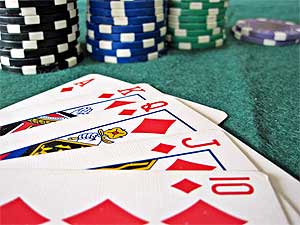 Those familiar with the Amber universe know one thing–everyone carries a deck of cards with them wherever they go. Granted, these aren’t your run-of-the-mill 52-card standard playing card decks. But gambling is a universal activity and card games are so wide-spread, I can’t image that the ultra-competitive Amber court wouldn’t develop ways to gamble with those ever-present decks.
Those familiar with the Amber universe know one thing–everyone carries a deck of cards with them wherever they go. Granted, these aren’t your run-of-the-mill 52-card standard playing card decks. But gambling is a universal activity and card games are so wide-spread, I can’t image that the ultra-competitive Amber court wouldn’t develop ways to gamble with those ever-present decks.
To that end, my heart-sister and college roommate Romilly Mueller got together and created a set of scoring rules that allowed us to play poker in character during our Amber Diceless games. Poker is such a common game, I won’t go over the basic rules here (especially since the best way to learn poker is from someone else who already knows it). This scoring can be used with any of the multitude of poker variants out there. My group tended to play seven card stud.
Scoring Hands
Here are the scoring hands of Trump Poker, from lowest score to highest:
- Highest Card: When none of the players has any valid combinations of cards, the player holding the highest value card wins the hand. Aces are high and beat all other cards except trumps (see Scoring Trumps, below).
- Highest Pair: Two cards of the same value. This is a very common hand, since all trumps are wild. If two or more players have a single pair, the highest value pair wins. If all players have pairs containing trumps, the pair containing the highest pip card wins. If all players have the same pip card or the pairs are all comprised of two trumps, the highest trump card (or card combination) wins. Hands of two trump cards lose against a “natural” pair (a pair made without wild cards).
- Two Pairs: Player with the highest pair wins. If the highest pair is tied, then the highest of the second pair wins. If that pair is also tied, the player with highest single remaining card wins.
- Blaze: Five court cards. If more than one person has a blaze, the highest pair in the blaze wins.
- Three of a Kind: The highest three of a kind wins. Again, “natural” hands beat those made with wild cards.
- Royal Blaze: This is unique to Trump Poker. A hand of only trumps, or four trumps and the Ace of Coins. If two or more players both have a royal blaze, then the hand containing the Ace of Coins wins. If no one has the Ace of Coins, then the hand with the highest trump or trump combination wins.
- Straight: Five cards in numerical order. Aces can be high or low, but scoring doesn’t “wrap.” That is, page, knight, queen, king, ace counts, as does ace, two, three, four, five. But queen, king, ace, two, three doesn’t.
- Flush: All five cards of the same suit, not in numerical order. If more than one player has a flush, the flush containing the highest card wins. If the highest cards tie, count the next highest cards and so on. In the event all cards tie, the highest suit wins (see Scoring Suits, below) Natural hands beat those made with wild cards. Note: the trumps aren’t considered a suit and any hand containing all trumps is considered a “blaze” and scores lower than a three of a kind.
- Full House: Three of a kind + a pair. If more than one player has a full house, the highest three of a kind wins. If three of a kinds tie, the highest remaining pair wins.
- Four of a Kind: Four cards of the same rank, plus any other card. If more than one player calls a four of a kind, the highest one wins. Note: it’s possible, given the high numbers of wild cards in this variant to have a “Five of a Kind”. This is considered a four of a kind and scored accordingly, remembering that a natural four of a kind beats a “five of a kind.”
- Straight Flush: Five cards of the same suit in numerical order. If there are multiple straight flushes, the straight flush containing the highest value card wins. This is the first of three hands that has to be made of natural cards. If the hand contains a wild card, it’s scored as a flush.
- Royal Flush: Ace, king, queen, knight, page, all of the same suit. This is the second of the three hands that must be natural to score. In the unlikely event of multiple royal flushes, the highest suit wins.
- Royal Hand: The final natural hand, this one is also unique to trump poker. This hand consists of Oberon, Eric, Corwin, Random, and the Ace of Coins. (All the people who have ever worn the crown of Amber, plus the Jewel of Judgement).
Scoring Suits
Unlike normal poker where all suits are equal, each suit in trump poker has a ranking (from lowest to highest scoring): coins (pentacles), cups, rods (staves/wands), and swords.
Scoring Trumps
When combined with other cards, all trumps are wild and take on the value of whatever hand contains them. When compared against each other, they have the ranks given below. Combinations of trump cards score higher than single trump cards.
On PC trumps: Usually only the trumps of the Elder Amberites (Corwin, Random, Oberon, Fiona, Dworkin, etc.) are used; all other trumps are discarded from the deck before play. Sometimes they “younger” trumps are left in, but score like the jokers in a regular playing card deck: they’re purely wild cards and have a rank of zero when compared to other trumps.
Single Trump ranking
From lowest scoring to highest: [Ryalle]*, Sand, Delwin, Random, Florimel, Gerard, Julian, Llewella, Caine, Brand, Bleys, Fiona, Deirdre, Corwin, Eric, Benedict, Finndo, Osric, Oberon, and Dworkin.
This ranking is based on birth order (with the exception of Ryalle), from youngest to oldest, as I determined it for my game. Change the order as you see fit for your own game.
*[Ryalle is the full sister of Benedict, Osric, and Finndo in my game and is one of the “dead or missing” siblings Corwin mentions in Nine Princes in Amber. She’s last in the rankings because she was exiled from Amber for supporting Osric and Finndo’s ambitions. ]
Trump Combinations Ranking
Combinations are a set of trumps combined with each other or with other cards in the deck. The Ace of Coins represents the Jewel of Judgement when combined with trumps, thus its presence in the highest-scoring combinations.
Here are the combination rankings (from lowest scoring to highest):
- Osric, Finndo, and Ryalle
- Osric and Finndo
- Julian and Fiona
- Corwin and Deirdre
- Florimel and any cup card (governing love and emotions)
- Eric and Florimel (Eric’s spy)
- Caine, Gerard, and Julian (called the “Dark Trio”)
- Fiona, Bleys, and Brand (the Cabal)
- Fiona and any rod (which represents sorcery)
- Benedict and any sword
- Brand and the Ace of Coins
- Corwin and the Ace of Coins
- Caine and any ace
- Benedict and the Ace of Swords
- Random and the Ace of Coins
- Dworkin and Oberon
- Oberon and the Ace of Coins
- Dworkin and the Ace of Coins
- Dworkin, Oberon and the Ace of Coins
Final note: Any hand, no matter what the other cards in the hand are (even if it’s a royal flush), that contains both Corwin and Eric is automatically a losing hand. The only exception to this is the “royal hand”, which beats everything.
 What can I say? I’ve loved this site for years–it’s been one of my favorites since I started reading RPG blogs and one of the ones I still check regularly, even with my limited computer time. Their mix of articles is wonderful, the writing is always top-notch and I always come away from it with ideas I want to apply to my game immediately. They’ve received ENnie awards in 2010 & 2011 and there’s a damn good reason why.
What can I say? I’ve loved this site for years–it’s been one of my favorites since I started reading RPG blogs and one of the ones I still check regularly, even with my limited computer time. Their mix of articles is wonderful, the writing is always top-notch and I always come away from it with ideas I want to apply to my game immediately. They’ve received ENnie awards in 2010 & 2011 and there’s a damn good reason why.


















